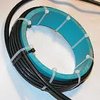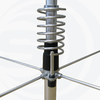Do your radials stick over the actual roof? If so this is most likely your main issue
222, you make a good point here. I'm at the limit for the number of segments my version of Eznec can use, 500. So, I had to make the antenna simple (no radials) using just a few segments.
I could try lowering the segment count for the roof part of the model, but I don't have a model with horizontal radials that produces a good match, and I don't know how to use the matching feature in Eznec.
I would venture to say if you were to move the antenna away from the metal roof your VSWR would go down like it should.
I think my model does not fix the SWR by either moving the antenna 70' feet away or raising it to 36' feet in height.
But I still would like to see what Marconi's plots show as far as the pattern and any ill effects the roof might have.
I've not been feeling well 222, and analyzing these models take concentration. I hope to finish later today. Maybe I had too much cigarettes, whiskey, and wild wild women over the New Years celebrations.
The roof isn't ideal but I wouldn't call it an issue.
So far in my considering my model of the situation here...I agree with 543 on his point.
The best place to fine tune it is where it will be used. That takes more work though.
I totally agree with 543 here, you just can't beat tuning at the working location and height.
Asuming your coax and connectors are in good shape and your meters are ok. I'd be willing to bet a common mode choke below the feed point will bring your readings closer together. If your SWR changes as a result it means you needed it.
I wish I had the confidence to make a feed line choke that worked on this model. If you have enough feed line, I would check 543's idea out by coiling a choke using the feed point end of your working feed line.
I'm not sure about the Tornado 27 and CMC's, but I would like to model it...if somebody can give me all the necessary dimensions to do a good model. IMO this vertical dipole I'm using here is prone to CMC. Sometimes raising an antenna changes things.









